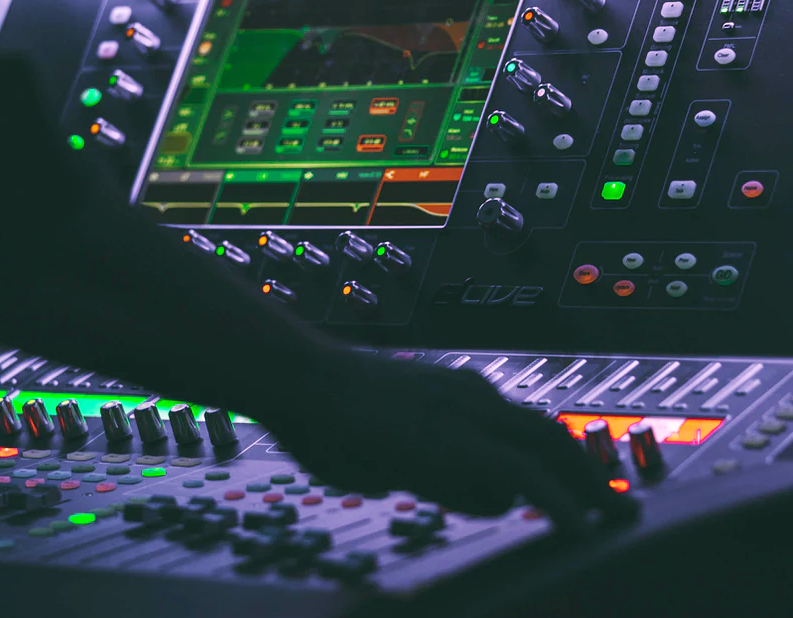Q: We get a great mix at our streaming console, but by the time we listen to it on Facebook, it sounds completely different. What’s the deal? – St. Paul, MN
A: To put it succinctly, compression. Without going down a total rabbit hole in answering this question, when we stream audio and video over the internet, a lot of compression is occurring at different stages. There’s the compression you’re applying on the individual channels, on the main streaming bus, at the codec (the piece of technology preparing your stream to be sent to the world wide web), and the platform you’re streaming on. Not even mentioning whatever changes might be happening on the medium the consumer is listening to the stream on.
Compress too much in the mix and it can sound completely lifeless and one-dimensional – never good. However, when streaming via the internet to popular platforms like Facebook, if the signal is too dynamic it actually ends up compressing the signal way too much to compensate. Online platforms prefer consistency.
Try limiting your streaming bus dynamics to no more than 6 dB. If you’re doing the compressing, you have much more control over the quality. Facebook (and many of the other platforms) don’t care at all about the quality of your audio. It’s a first-come, first-served world when we stream for free – all that they’re concerned about is making sure it’s just audible, not beautiful.
This means being vigilant about huge dynamic changes between individual speakers (people talking) and musical numbers. A band is louder than a single person talking, yes?
Be prepared to compensate for that. Always be watching he stream bus output meter.
It’s also just a good idea to not have huge level variances when streaming for the end listener. If I’m listening on earbuds I don’t want to have to blast my volume when someone is praying, only to have my ears bleed as soon as the band kicks in. Of course, we want a little bit of dynamics but we can’t play into it like we do in a regular service with lots of real humans in attendance.
Certain platforms, such as YouTube, work harder to retain audio quality in the stream, so if possible, I suggest streaming to YouTube. It takes a little effort to get up and running, but you’ll have a much better experience.
Also, bear in mind that a mix will never sound exactly like it does in person. Listening after the fact offers valuable information on the changes that need to be made. Any engineer worth their salt should be listening back to their own mixes. If you aren’t yet, make it a habit!
Q: Networked audio seems to be a hot topic on the church audio forums. What’s the best option? – Boston, MA
A: There are several options. I can’t definitively say if one is “better” over another; rather, more like “which networking platform do you prefer to work with?” A select few options available are Dante by Audinate (proprietary), Soundgrid by Waves (proprietary), AES67 (non-proprietary), and AVB (non-proprietary).
Recognize that once you buy into a certain protocol it’s best to stick with it unless you’re redesigning an entire system. Some digital consoles allow the use of “tielines” to change between protocols without requiring any of the console’s processing power. If you’re working with one of those, by all means mix and match as you please. A few key points about each protocol:
Dante. Works well once the system is up, but in my experience as well as several of my colleagues, it can be a bit finicky. It also adds a significant amount of latency, but on the other hand, is offered by numerous (almost all) pro audio equipment manufacturers, so that’s an advantage in terms of flexibility and implementing it. Also note that Dante now supports video as well.
Soundgrid. Meant to function in tandem with Waves software, interfaces, and digital racks, and if you really want to implement Waves into your system, you’ll likely need Soundgrid. Many console manufacturers offer Soundgrid cards, making implementation pretty straightforward and easy to achieve.
AES67. Can run at a sample rate of up to 96 kHz and has unlimited network capacity. It can also be on the same network as control information, unlike some other protocols. It’s not proprietary so nobody “owns” it, which can make it a very affordable option.
AVB. Also not proprietary, it’s an audio/video bridging protocol that will run at a sample rate of up to 192 kHz and will run in less than 2 milliseconds. (Some protocols wish they could be so quick.) The future of AVB is being determined as you read this, and it’s my hope that we continue to support non-proprietary protocols to retain affordability.
Different console manufacturers support different protocols. Do a bit of research on which consoles you fancy and discover which protocols might be easiest to set up and support. There is no “right” answer.
Q: What’s the best EQ curve for X instrument or Y microphone? – Anywhere, USA
A: Wow, if it were only this simple. If it were truly, every single person who had an EQ curve photo on their smartphone could be on tour with Adele. Alas, it’s not meant to be. There are far too many variables to have a hard-and-fast rule such as “this is the best EQ curve for a kick drum.”
I suppose I could argue that the best EQ curve for any input is flat. In other words, no EQ. Ideally, the instrument, artists, and PA are all perfect and I don’t have to do anything at all except amplify it. Let’s be realistic, though. At least one of those things are going to be “off” or ill-fitted for the situation.
The best I can suggest are rules of thumb. Starting points, if you will. Here’s how I approach a few popular worship instruments. And remember, friends don’t let friends ask for EQ curve suggestions.
Kick. I like a punchier kick, so I don’t want it sitting too low. I will start with a high-pass filter (HPF) around 60 to 80 Hz. If I’m not getting enough of the pedal, I do a slight boost of 2 to 3 dB around 1 kHz. We can’t make the kick drum sound like anything it isn’t.
Bass. Lately, I’ve been letting bass guitar sit lowest in the mix. I’ll add a HPF at 25 to 30 Hz and a slight cut at 1 kHz to A) cut down on fret noise, and B) give a little more space for the drum pedal. If I need some more “meat” in the bass I do a little boost in the 60 to 80 Hz region for that chest-thump vibe.
Guitar. I only high-pass (filter) this instrument when I’m trying to fit two or more guitars with similar musical parts together. When I need to do that, a cut in one guitar with a boost at the same frequency in the other guitar can help create a bit of space for each instrument. Otherwise, I address any timbre concerns with the guitarist. They often work endlessly (and I do mean endlessly) on their tone. I’m not about to be the one to mess with it!
Snare. I enjoy having miking both the top and bottom of a snare. The more the merrier, as they say… I EQ the top to be the lower end of the spectrum and let the bottom (where the actual snare is) be the “crack” part (around 1 kHz.) High-pass filters do most of my heavy lifting.




















